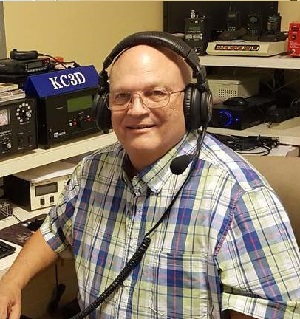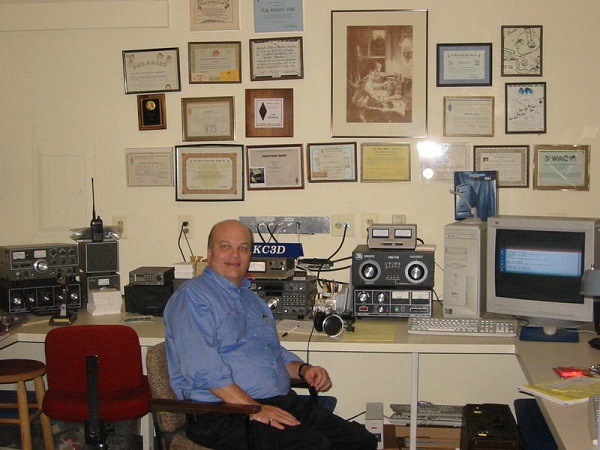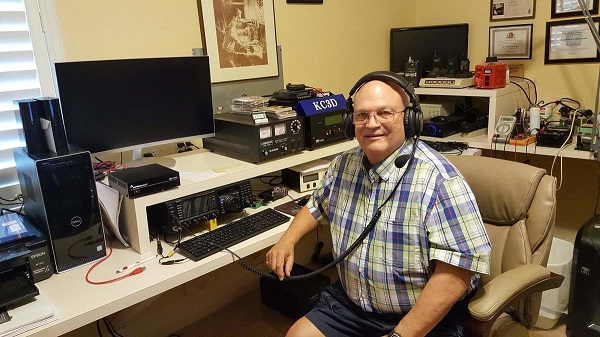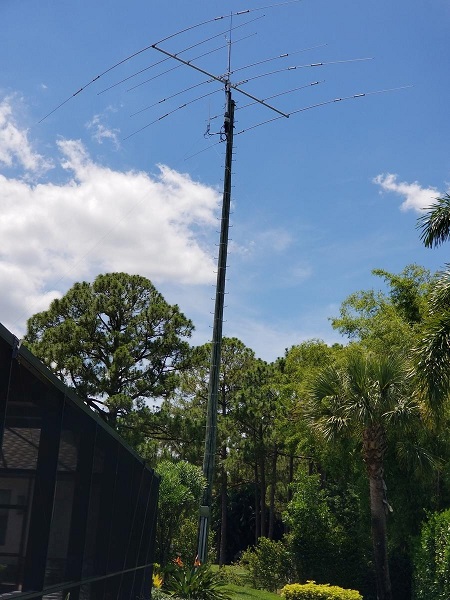|
KC3D Howard M. Rensin Palm Beach Gardens, FL QCWA # 16015 Chapter 111 |
 |
Member: South Florida DX Assoc., Florida Contest Group, West Palm Beach Amateur Radio Group, Palms West ARC, Potomac Valley Radio Club (PVRC), Columbia (Maryland) Amateur Radio Assoc. (CARA), QRP ARCI # 14682, NAQCC # 3738, SKCC # 10179, Life Member ARRL; QCWA # 16015 and Ten-Ten #: 25711. Grid: EL96wv.
Around the time I was 11 years old, I became a Cub Scout. I had seen crystal radios so my merit badge lead me directly to the crystal radio kit which was breadboarded on a cardboard photo layout of the parts. I then moved up to the one tube radio, which was an Air Champ kit that came in a cardboard box, through which the control shafts extended.
Shortly after that I received an Ed-U-Kit which was a metal chassis with three tube sockets punched into it along with other holes. The idea was that you started out building the first project; a one tube receiver, and then take it apart and used the parts and some of the other parts to move on to project number two and so on until you had build twenty such projects and had graduated to a three tube project.
The Ed-U-Kit did not have a transformer. It rectified the household voltage and used that as plate current. The filament voltage was developed by a resistance wire contained in the power cord that dropped the voltage from the household 110 to about 6 volts for the filaments. The cord heated up to a toasty level and I'll bet it would not pass the safety tests of today, but it was very effective.
As an adult who has been a bit of a nostalgia buff, I have gone back and obtained working versions of each of those kits and now keep them as part of a collection.
I was issued my novice ticket on my 14th. birthday, July 31, 1957 in Syracuse, NY. Having passed my novice exam a few weeks earlier and first licensed as WN2THJ. I sent away for a Heathkit DX-35 and spent the better part of the summer trying to put it together. Fortunately, I had some help and finally got it working. I had purchased a Hallicrafter S-20R general coverage receiver from the father of a friend who lived across the street for $15. It drifted so badly, that every time I stopped transmitting and went to receive, it was a mystery where I would be listening. After a while I learned to let it warm up for a half an hour before starting a QSO. In those days, novices were limited to xtal controlled transmitters no greater than 75 watts. I had limited funds so I only bought one xtal and worked all my novice contacts on 7175 kHz.
The novice license then was only good for one year and not renewable. I upgraded to Technician and the call sign was changed to W2THJ but was not able to master the CW until much later in life.
When I moved to Maryland in 1964 I was assigned W3ECN which I kept until I upgraded to extra in 1980 and received the KC3D callsign. In those days you had to pass a 20 wpm Morse code test.
I was a member of the board of directors of the Columbia Amateur Radio Assoc. which is the club for Howard County, Maryland before my move to Florida in November of 2014. I was active in RACES, ARES and Field Day (joint effort by Columbia Amateur Radio Assoc. and Potomac Valley Radio Club) and have taken the lead in organizing a ham radio club at the local community college in Howard County, MD.
Since moving to Florida, I am the vice Pres. of Chapter 111 of the Palm Beach FL QCWA and a member of both the Palms West ARC and the West Palm ARG along with South Florida DX Assoc. I was on the nominating committee for QCWA national officers and directors in 2019.
My tower consists of a wooden 70 foot telephone pole that I had installed in my backyard and on which I have a Mosley Pro 67C-3 Yagi and a UHF/VHF vertical along with an 80/160 trap dipole. I installed metal steps in the pole so it can be easily climbed rather than having to use cleats. Adding the steps made it easier to climb than some towers. See below for photo of my tower.
My DXCC score is 259 per LoTW. I use an Orion OR2800 rotator and a Green Heron RT-21 controller. My current rig is a Yaesu FTDX 3000 D driving a Ameritron ALS -1306 solid state amp. Nice amp but touchy about what it likes to see. I use a Palstar HF-AUTO tuner to smooth things out for the Ameritron.
I have met many great friends and interesting people from ham radio. Radio was my first love (crystal set at age 7) and has always been a part of my life and hope always will.
Having moved to Florida in November of 2014, I have met a lot of the local hams and continuing to increase my DXCC count as well as contest activity.



July 6, 2022